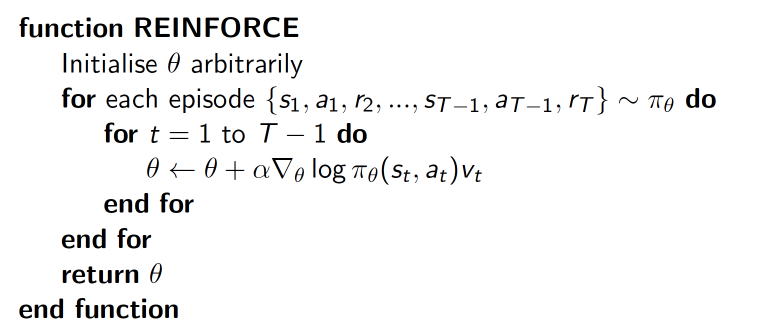深度增强学习--Policy Gradient
前面都是value based的方法,现在看一种直接预测动作的方法 Policy Based
Policy Gradient

下面的例子实现的REINFORCE算法
import sys
import gym
import pylab
import numpy as np
from keras.layers import Dense
from keras.models import Sequential
from keras.optimizers import Adam EPISODES = 1000 #policy gradient的一种,REINFORCE算法
# This is Policy Gradient agent for the Cartpole
# In this example, we use REINFORCE algorithm which uses monte-carlo update rule
class REINFORCEAgent:
def __init__(self, state_size, action_size):
# if you want to see Cartpole learning, then change to True
self.render = True
self.load_model = False
# get size of state and action
self.state_size = state_size#
self.action_size = action_size# # These are hyper parameters for the Policy Gradient
self.discount_factor = 0.99
self.learning_rate = 0.001
self.hidden1, self.hidden2 = 24, 24 # create model for policy network
self.model = self.build_model() # lists for the states, actions and rewards
self.states, self.actions, self.rewards = [], [], [] if self.load_model:
self.model.load_weights("./save_model/cartpole_reinforce.h5") # approximate policy using Neural Network
# state is input and probability of each action is output of network
def build_model(self):
model = Sequential()
model.add(Dense(self.hidden1, input_dim=self.state_size, activation='relu', kernel_initializer='glorot_uniform'))
model.add(Dense(self.hidden2, activation='relu', kernel_initializer='glorot_uniform'))
model.add(Dense(self.action_size, activation='softmax', kernel_initializer='glorot_uniform'))
model.summary()
# Using categorical crossentropy as a loss is a trick to easily
# implement the policy gradient. Categorical cross entropy is defined
# H(p, q) = sum(p_i * log(q_i)). For the action taken, a, you set
# p_a = advantage. q_a is the output of the policy network, which is
# the probability of taking the action a, i.e. policy(s, a).
# All other p_i are zero, thus we have H(p, q) = A * log(policy(s, a))
model.compile(loss="categorical_crossentropy", optimizer=Adam(lr=self.learning_rate))
return model # using the output of policy network, pick action stochastically
def get_action(self, state):
policy = self.model.predict(state, batch_size=1).flatten()#
return np.random.choice(self.action_size, 1, p=policy)[0]#choose action accordding to probability # In Policy Gradient, Q function is not available.
# Instead agent uses sample returns for evaluating policy
def discount_rewards(self, rewards):
discounted_rewards = np.zeros_like(rewards)
running_add = 0
for t in reversed(range(0, len(rewards))):
running_add = running_add * self.discount_factor + rewards[t]
discounted_rewards[t] = running_add
return discounted_rewards # save <s, a ,r> of each step
def append_sample(self, state, action, reward):
self.states.append(state)
self.rewards.append(reward)
self.actions.append(action) # update policy network every episode
def train_model(self):
'''
example:
self.states:[array([[-0.00647736, -0.04499117, 0.02213829, -0.00486359]]), array([[-0.00737719, -0.24042351, 0.02204101, 0.2947212 ]]), array([[-0.01218566, -0.04562261, 0.02793544, 0.00907036]]), array([[-0.01309811, -0.24113382, 0.02811684, 0.31043471]]), array([[-0.01792078, -0.04642351, 0.03432554, 0.02674995]]), array([[-0.01884925, -0.24202048, 0.03486054, 0.33006229]]), array([[-0.02368966, -0.04741166, 0.04146178, 0.04857336]]), array([[-0.0246379 , -0.24310286, 0.04243325, 0.35404415]]), array([[-0.02949995, -0.43880168, 0.04951413, 0.65979978]]), array([[-0.03827599, -0.2444025 , 0.06271013, 0.38310959]]), array([[-0.04316404, -0.44035616, 0.07037232, 0.69488702]]), array([[-0.05197116, -0.63637999, 0.08427006, 1.00886738]]), array([[-0.06469876, -0.83251953, 0.10444741, 1.32677873]]), array([[-0.08134915, -0.63885961, 0.13098298, 1.06852366]]), array([[-0.09412634, -0.44569036, 0.15235346, 0.8196508 ]]), array([[-0.10304015, -0.25294509, 0.16874647, 0.57850069]]), array([[-0.10809905, -0.44997994, 0.18031649, 0.91923131]]), array([[-0.11709865, -0.25769299, 0.19870111, 0.68820344]])]
self.rewards:[1.0, 1.0, 1.0, 1.0, 1.0, 1.0, 1.0, 1.0, 1.0, 1.0, 1.0, 1.0, 1.0, 1.0, 1.0, 1.0, 1.0, -100]
self.actions:[0, 1, 0, 1, 0, 1, 0, 0, 1, 0, 0, 0, 1, 1, 1, 0, 1, 1]
'''
episode_length = len(self.states)# discounted_rewards = self.discount_rewards(self.rewards)
'''
example:
disconnted_rewards:array([ -68.58863868, -70.29155422, -72.01167093, -73.74916255,-75.5042046 , -77.27697434, -79.06765085, -80.876415 , -82.7034495 , -84.54893889, -86.41306958, -88.29602988,-90.19800998, -92.119202 , -94.0598,-96.02,-98., -100. ])
'''
discounted_rewards -= np.mean(discounted_rewards)
discounted_rewards /= np.std(discounted_rewards)#将作为神经网络预测对象
'''
array([ 1.59468271, 1.41701722, 1.23755712, 1.05628429, 0.87318042,
0.68822702, 0.50140541, 0.3126967 , 0.12208185, -0.0704584 ,
-0.26494351, -0.46139311, -0.65982705, -0.86026537, -1.06272832,
-1.26723636, -1.47381013, -1.6824705 ])
'''
update_inputs = np.zeros((episode_length, self.state_size))#shape(18,4)
advantages = np.zeros((episode_length, self.action_size))#shape(18,2) for i in range(episode_length):
update_inputs[i] = self.states[i]
advantages[i][self.actions[i]] = discounted_rewards[i] self.model.fit(update_inputs, advantages, epochs=1, verbose=0)
self.states, self.actions, self.rewards = [], [], [] if __name__ == "__main__":
# In case of CartPole-v1, you can play until 500 time step
env = gym.make('CartPole-v1')
# get size of state and action from environment
state_size = env.observation_space.shape[0]
action_size = env.action_space.n # make REINFORCE agent
agent = REINFORCEAgent(state_size, action_size) scores, episodes = [], [] for e in range(EPISODES):
import pdb; pdb.set_trace()
done = False
score = 0
state = env.reset()
state = np.reshape(state, [1, state_size]) while not done:
if agent.render:
env.render() # get action for the current state and go one step in environment
action = agent.get_action(state)
next_state, reward, done, info = env.step(action)
next_state = np.reshape(next_state, [1, state_size])
reward = reward if not done or score == 499 else -100 # save the sample <s, a, r> to the memory
agent.append_sample(state, action, reward) score += reward
state = next_state if done:
# every episode, agent learns from sample returns
agent.train_model() # every episode, plot the play time
score = score if score == 500 else score + 100
scores.append(score)
episodes.append(e)
pylab.plot(episodes, scores, 'b')
pylab.savefig("./save_graph/cartpole_reinforce.png")
print("episode:", e, " score:", score) # if the mean of scores of last 10 episode is bigger than 490
# stop training
if np.mean(scores[-min(10, len(scores)):]) > 490:
sys.exit() # save the model
if e % 50 == 0:
agent.model.save_weights("./save_model/cartpole_reinforce.h5")
深度增强学习--Policy Gradient的更多相关文章
- 强化学习--Policy Gradient
Policy Gradient综述: Policy Gradient,通过学习当前环境,直接给出要输出的动作的概率值. Policy Gradient 不是单步更新,只能等玩完一个epoch,再 ...
- 深度增强学习--DDPG
DDPG DDPG介绍2 ddpg输出的不是行为的概率, 而是具体的行为, 用于连续动作 (continuous action) 的预测 公式推导 推导 代码实现的gym的pendulum游戏,这个游 ...
- 深度增强学习--A3C
A3C 它会创建多个并行的环境, 让多个拥有副结构的 agent 同时在这些并行环境上更新主结构中的参数. 并行中的 agent 们互不干扰, 而主结构的参数更新受到副结构提交更新的不连续性干扰, 所 ...
- 深度增强学习--Actor Critic
Actor Critic value-based和policy-based的结合 实例代码 import sys import gym import pylab import numpy as np ...
- 深度增强学习--Deep Q Network
从这里开始换个游戏演示,cartpole游戏 Deep Q Network 实例代码 import sys import gym import pylab import random import n ...
- 深度增强学习--DPPO
PPO DPPO介绍 PPO实现 代码DPPO
- 深度增强学习--DQN的变形
DQN的变形 double DQN prioritised replay dueling DQN
- Deep Learning专栏--强化学习之从 Policy Gradient 到 A3C(3)
在之前的强化学习文章里,我们讲到了经典的MDP模型来描述强化学习,其解法包括value iteration和policy iteration,这类经典解法基于已知的转移概率矩阵P,而在实际应用中,我们 ...
- 增强学习 | AlphaGo背后的秘密
"敢于尝试,才有突破" 2017年5月27日,当今世界排名第一的中国棋手柯洁与AlphaGo 2.0的三局对战落败.该事件标志着最新的人工智能技术在围棋竞技领域超越了人类智能,借此 ...
随机推荐
- 使用Frida简化Android端应用安全测试
@author : Dlive 在对Android应用进行Web漏洞测试时,经常遇到一种情况:HTTP传输的数据带有签名字段 处理这种情况的方法通常是逆向签名算法,但是如果算法在so中,而且so加壳了 ...
- Django-models,继承AbstractUser类
1.UserInfo类继承了Django模型自带的User类,需要导入AbstractUser 2.然后在settings.py中配置
- Linux执行shell脚本方式及区别&命令后台运行
Linux执行shell脚本方式及区别&命令后台运行 http://blog.csdn.net/heqiyu34/article/details/19089951/
- linux下C的GBD调试学习笔记(转载)
1. 单步执行和跟踪函数调用 看下面的程序: 例 10.1. 函数调试实例 #include <stdio.h> int add_range(int low, int high) { in ...
- Android的简单应用(三)——为你的程序添加监听器
平时在写程序时经常会遇到监听器,比如按钮的click监听器,按键监听器等等.而android中的监听器和java中的回调函数是同一个概念,都是在底层代码中定义一个接口来调用高层的代码.那么什么是回调函 ...
- web开发文档整理
django 1.11版中文文档 django 1.11版英文文档 Redis命令参考文档 Axios中文文档 Axios英文官方文档 Django REST Framework官方文档 Vue.js ...
- 【SQL】约束与触发器1
一.外键 1.1特点 表A的外键,一定是其他某个表B的主键或有UNIQUE声明的属性. A的外键的值,一定是对应表B中相应的属性值.(空值除外) 1.2声明方法 方法1:属性名 类型 REFERENC ...
- Annotation(注解)代替配置文件
非注解形式,即指在配置文件中配置相关参数,使实体类.参数各方面分离.注解方式,即annotation方式,是jdk提供的一种注入或配置方式.即将实体类与相关参数都在一起,只是通过@annotation ...
- poj 3230(初始化。。动态规划)
Travel Time Limit: 1000MS Memory Limit: 65536K Total Submissions: 4353 Accepted: 1817 Descriptio ...
- duboo服务使用thrift协议 + MQ
写一篇博客来记录从 Python 转型到 Java 的学习成果.整体架构: rpc: dubbo + thrift idl: thrift registeration: zookeeper MQ: k ...
